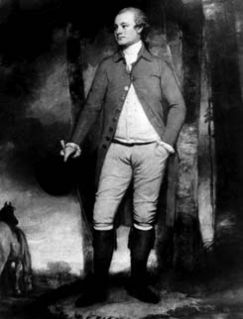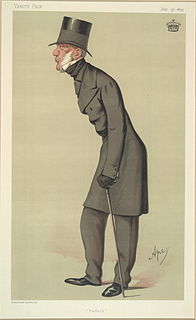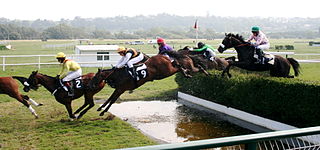
Stockwell (1849–1871) was a British Thoroughbred racehorse and a Leading sire in Great Britain & Ireland seven times; he was second on the sires' list a further four times during a 14-year period.

Doncaster was an English Thoroughbred racehorse and sire. He was the winner of the 1873 Epsom Derby and the sire of the great stallion Bend Or. Through Bend Or he is the direct male-line ancestor of most modern thoroughbreds.
Reel was a thoroughbred race horse, and one of the greatest American Thoroughbred broodmares in history.

Eleanor was a British Thoroughbred racehorse bred by Charles Bunbury and was the first female horse to win The Derby. Eleanor also won the 1801 Epsom Oaks among many other races before retiring from racing at age eight to become a broodmare for Bunbury. She produced the stallion Muley, which in turn sired the mare Marpessa and the influential stallion Leviathan which was exported to the United States in the early nineteenth century. Through the produce of her daughter Active, Eleanor is present in the pedigrees of 19th-century American Standardbred racehorses.
The Alexander mare was an unnamed British Thoroughbred broodmare. She never raced, but at stud she foaled Castrel, Selim, Bronze and Rubens. Both Selim and Rubens became Champion sire in Britain.

Nike was a British Thoroughbred racehorse. She won three of her five starts, including the Oaks Stakes in 1797. She was owned Richard Grosvenor, 1st Earl Grosvenor, and later became a broodmare, with three of her foals placing in Classic races.

Pope Joan was a British Thoroughbred racehorse. She won four of her eight starts before being retired to stud, where she became a successful broodmare. She foaled 1000 Guineas winner Tontine, 2000 Guineas winner Turcoman and Epsom Oaks winner Turquoise. Pope Joan was bred by Augustus FitzRoy, 3rd Duke of Grafton and after his death was owned by his son George FitzRoy, 4th Duke of Grafton.

Young Giantess (1790–1811) was a British Thoroughbred racehorse and broodmare. She failed to win any of the five races she contested, but became a successful broodmare for Sir Charles Bunbury. She foaled the successful sire Sorcerer and Derby and Oaks winner Eleanor.

Altisidora (1810–1825) was a British Thoroughbred racehorse and broodmare best known for winning the classic St Leger Stakes in 1813. Bred, trained and raced in Yorkshire she won two of her three races as a two-year-old in 1812. She was unbeaten for the next two seasons, winning three races including the St Leger at Doncaster as a three-year-old and four as a four-year-old in 1814. In her final season she won four of her eight races including a Great Subscription Purse at York, the Fitzwilliam Stakes at Doncaster and a King's Plate at Richmond. She was retired to stud, where she had some impact, being the grand-dam of Ralph, the winner 2000 Guineas and the Ascot Gold Cup. Altisidora died in 1825 at the age of fifteen.

Bridget (1776–1798) was a British Thoroughbred racehorse who won the inaugural running of the Oaks Stakes in 1779. She was bred and owned by Edward Smith-Stanley, 12th Earl of Derby, for whom she produced five foals as a broodmare.
Height of Fashion was French-bred, British-trained Thoroughbred racehorse and broodmare. Owned and bred by Queen Elizabeth II, was undefeated in her three races as a two-year-old in 1981, winning the Acomb Stakes, May Hill Stakes and Fillies' Mile. In the following year she added a win in the Lupe Stakes before a record-breaking victory in the Princess of Wales's Stakes. She ran poorly in her two remaining races and was retired to stud at the end of the season. Height of Fashion proved to be an exceptional broodmare, producing the major stakes winners Unfuwain, Nashwan and Nayef. She died in Kentucky in 2000.
Imperatrix was a British Thoroughbred racehorse. She raced only twice, with her only win coming in the 1782 St. Leger Stakes. She was bred and owned by John Pratt. As a broodmare, Imperatrix produced nine foals.
Lady Capulet was an American-bred, Irish-trained Thoroughbred racehorse and broodmare. Her brief track career consisted of only three races in May and June 1977. She won the Irish 1000 Guineas on her debut before finishing second in the Coronation Stakes and third in the Pretty Polly Stakes. She was retired from racing to become a broodmare and made a major impact as the dam of the leading stallion El Prado.
Ambiguity was a British Thoroughbred racehorse and broodmare best known for winning the 1953 Epsom Oaks. After finishing unplaced on her only start as a two-year-old she improved to become a top-class stayer in 1953. She won the White Rose Stakes, Oaks Stakes and Jockey Club Cup as well as finishing second in the Cheshire Oaks and the Oxfordshire Stakes. After her retirement from racing she had some success as a broodmare.
Lovely Rosa was an Irish-bred, British-trained Thoroughbred racehorse and broodmare best known for her win in the 1936 Epsom Oaks. As a juvenile in 1945 she showed some promise when finishing second in the Queen Mary Stakes and winning a race at Newbury but then showed little worthwhile form until her 33/1 upset victory in the Oaks. She never won again and was retired at the end of 1936. She had some success as a broodmare, most notably being the grand-dam of Wilwyn.
Short Story was a British Thoroughbred racehorse and broodmare. After showing considerable promise as a two-year-old, Short Story finished third in the 1000 Guineas in the following spring and then won the Epsom Oaks by four lengths. She never won again but was placed in the Nassau Stakes, Yorkshire Oaks and Park Hill Stakes. As a broodmare she produced one good racehorse, but otherwise made little impact as a dam of winners.
Campanula was a British Thoroughbred racehorse and broodmare. In 1933 she won two of her five races including the Windsor Castle Stakes and the Moulton Stakes and was rated the best juvenile filly in England. In the following spring she won the Column Produce Stakes and then recorded her biggest win in the 1000 Guineas. In her two subsequent races she finished fourth in the Epsom Oaks and second in the Champion Stakes. As a broodmare she exerted an enduring influence as a broodmare through her daughter Calluna.
Queenpot was a British Thoroughbred racehorse and broodmare. She won three times as a juvenile in 1947, with her biggest success of the year coming in the Prendergast Stakes at Newmarket Racecourse. In the following spring she took the Katheryn Howard Stakes before recording her most significant victory in the 1000 Guineas. As a broodmare she produced several minor winners including the dam of Northjet.
Asmena was a French Thoroughbred racehorse and broodmare. She is best known for her victory in the 1950 Epsom Oaks when she overcame lameness to record a decisive win over a strong field. After being retired from racing at the end of the year she had some success as a dam of winners.
















